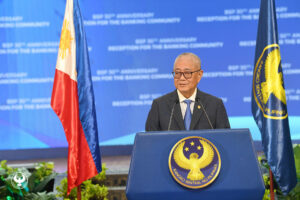




Quarterly Economic Growth Release: More BSP cuts to come
 DOWNLOAD
DOWNLOAD

Monthly Economic Update: Fed catches up
 DOWNLOAD
DOWNLOAD

Inflation Update: Steady and mellow
 DOWNLOAD
DOWNLOAD


BSP sees ‘prudent’ pause in tightening

The Bangko Sentral ng Pilipinas (BSP) may extend its “prudent” pause at next week’s meeting, but some analysts expect rate cuts to begin this year after the economy’s weaker-than-expected growth in the second quarter.
BSP Governor Eli M. Remolona, Jr. on Thursday said the central bank has not adjusted its policy settings at its last two meetings because they have been reconsidering and reassessing evolving domestic developments.
“The data is still mixed so we’re not sure. We haven’t been sure whether to raise or even to cut. But for now, we’re at a pause and we’re reassessing the situation. So that’s where we stand,” he said during the Development Budget Coordination Committee’s (DBCC) briefing before the House Committee on Appropriations.
However, Mr. Remolona told reporters the unexpectedly slower gross domestic product (GDP) growth in the second quarter is a “cause for concern.”
The Philippine economy expanded by an annual 4.3% in April to June, slower than the 6.4% growth in the first quarter and 7.5% a year earlier. It was below the 6% median forecast in a BusinessWorld poll of 21 economists last week.
Asked if the BSP will consider rate cuts due to the slower Q2 growth, Mr. Remolona said: “We’re not sure because it’s one number and we’re looking at a lot of other numbers.”
He expressed confidence the economy would pick up again in the second half.
“We think by the end of the year we will hit something like 6%,” he added.
For the first half, GDP growth averaged 5.3%. To meet the government’s 6-7% goal, GDP needs to grow by at least 6.6% in the second half.
Mr. Remolona said inflation is on track to return to the 2-4% target by the fourth quarter due to aggressive monetary tightening, giving “cause for a prudent pause.”
Headline inflation slowed for a sixth straight month to a 16-month low of 4.7% in July from 5.4% in June. From January to July, inflation averaged 6.8%, still higher than the 5.4% forecast by the central bank.
The Monetary Board raised borrowing costs by 425 basis points (bps) from May 2022 to March 2023. This brought the key interest rate to a near 16-year high of 6.25%.
However, Mr. Remolona cited several upside risks to the inflation outlook such as transport fare and wage hikes, food supply constraints, and the El Niño weather event.
Ryota Abe, an economist of the Global Markets and Treasury Department, Asia Pacific Division at Sumitomo Mitsui Banking Corp. (SMBC), said weak economic growth could prompt the central bank to cut rates later in the year.
“The latest GDP data will no doubt make BSP more wary than ever of an economic slowdown. BSP’s concern is expected to shift from inflation to the economy going forward,” Mr. Abe said in a note.
He noted that elevated prices and high-interest rates have had a moderately negative impact on household consumption.
However, since the BSP is still concerned about high inflation, it will be difficult to start easing immediately, Mr. Abe said.
The policy rate may be kept at 6.25% at the Aug. 17 meeting.
“Currently, there are concerns in Asia about a sharp rise in rice prices and food prices due to the El Niño phenomenon. In light of these factors, it is likely that data will not confirm that inflation has fallen sufficiently until the November meeting,” Mr. Abe said.
Makoto Tsuchiya, an assistant economist at Oxford Economics, said he expects the BSP to keep rates steady next week.
“Inflation is steadily declining, and the peso is not at the level that will prompt the BSP to hike to fight against depreciation pressures,” he said.
However, second-quarter GDP data raised the possibility that the central bank may start cutting before the yearend, as the Philippine economy is starting to feel the pain of monetary tightening, he said.
“Given the bleak outlook for the global economy, the BSP may feel the need to prop up domestic demand by pivoting sooner,” he said.
Meanwhile, the BSP governor also said they are comfortable with the narrower interest rate differential with the US Federal Reserve.
“What the market seems to be focusing on is what happens on the differential over time. Forward guidance from the Fed matters, forward guidance from the BSP matters,” he said.
The US central bank raised the federal fund rate target by 25 bps to 5.25-5.5%, the highest level in more than two decades.
Mr. Abe said the BSP might even cut rates ahead of the US Federal Reserve, as SMBC only expects the Fed to start easing in the first quarter next year.
“Based on the view that BSP cuts rates first, the interest rate differential between the US and the Philippines will narrow. From this perspective, the possibility of the peso depreciating against the dollar cannot be ruled out,” he said.
“If the rise is significant, BSP may hesitate to cut rates, even if the economic slowdown intensifies. As such, a rate cut by BSP in the near future can be justified from the real economy perspective, but not if there is excessive volatility in the currency markets,” he added.
After Aug. 17, the BSP will hold policy-setting meetings on Sept. 21, Nov. 16, and Dec. 14. — Keisha B. Ta-asan with Luisa Maria Jacinta C. Jocson
This article originally appeared on bworldonline.com





 By BusinessWorld
By BusinessWorld